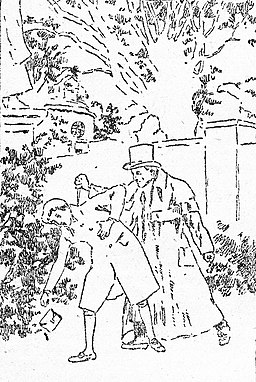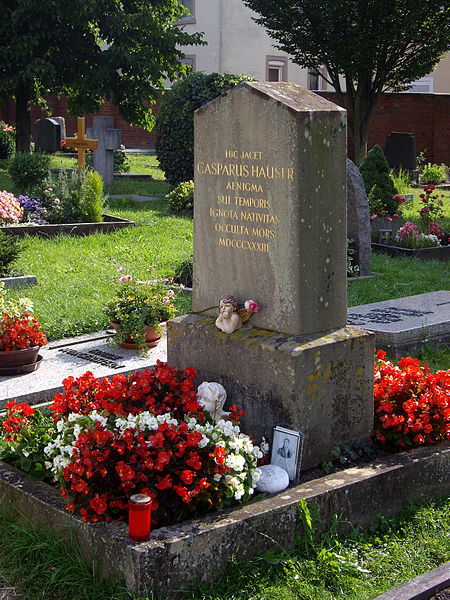
The incredible tale of Kaspar Hauser is a most unusual story. Why? Because it’s about a sudden appearance of a person rather than the much more common disappearance. So, just what is the shadowy 19th-century tale of Kaspar Hauser?
Sudden Appearance
The story of Kaspar Hauser began on 26 May 1828, when he surreptitiously arrived on the streets of Nuremberg. The rather stocky young man of about sixteen was quaintly but shabbily dressed. His boots were so worn they had caused his feet to become dirty and bloodied from walking in them.

A depiction of Kaspar Hauser’s first appearance in 1828
Speaking in a coarse Bavarian dialect, he just about managed to utter a few words to passers-by. He asked to be directed to the address of a local cavalry officer, which was shown on the two letters that he was clutching. Hauser’s strange dress and bizarre behaviour soon brought him to the attention of the local police, who took him into custody.
Hauser was found to have a minimal vocabulary that consisted mainly of words related to horses. He would normally only speak to mimic words and phrases that had just been spoken to him by others. Observers reported that although clearly not demented, he behaved as though he were a young child. Strangely, his damaged feet were said to be “as soft as the palm of a hand,” as though he’d previously never worn shoes.
One of the notes held by Hauser claimed that the author was not a blood relative of the boy but had still raised him as a son. It curiously said that since 1812, Hauser had not gone “a step from the house, so that nobody might know where he was brought up.” The mysterious note also claimed that the boy had ambitions to become “a horseman like his father.” The narrative had an ominous ending, stating that “it would cost me my neck” had he (the author), escorted Hauser to his destination in Nuremberg.
An Extraordinary Story
Hauser reportedly rejected all food and beverage except for bread and water. When presented with a lit candle, he stared at it in amazement and tried to grab it, burning his hand. He seemed to find endless fascination with his own reflection in a mirror. It was said he could see in the dark and that his other senses were unusually sharp. Despite his alleged upbringing, he proved to be an excellent student, learning to read, write, and speak remarkably.
Now literate, Hauser was able to tell his extraordinary story. He claimed that he had been raised in a room with boarded-up windows. He said he’d never left the room, and that his whole existence had been totally devoid of human contact. He claimed to have only ever been fed bread and water, yet he was in reasonable health, with no vitamin deficiency.
Hauser said that he had been brought to Nuremberg by a man who had forced him to look only downwards for the whole journey. The stranger had then handed him some letters and quickly disappeared. He also described a hazy dream to his therapist, Professor Daumer. In the dream, he said he found himself in a huge castle in the company of an elegantly dressed man and woman. Daumer theorised this could have been a faded memory of his early life before his incarceration.
Fame and Notoriety

Phillip Henry, Lord Stanhope by Samuel William Reynolds
Hauser was eventually made a ward of the city and put into the custody of a visiting British nobleman, Phillip Henry, Lord Stanhope. The nobleman had taken a great interest in his story. Initial public sympathy saw Hauser awarded a small pension. And, with numerous newspaper articles being published, word quickly began to spread about his incredible story. However, shortly after this time, Hauser began to have his detractors, who claimed his letters were fraudulent.
Some claimed the two letters were penned by the same hand even though they were supposed to have been from different originators. They also maintained that one of the letters was clearly a forgery. It had supposedly been written and addressed to the local cavalryman in 1812 before the man had ever lived in Nuremberg. However, by this time, Hauser had become internationally famous. In 1829, he even published his autobiography, which gave intimate details of his supposed appalling upbringing.
By now, those who had been charged with Hauser’s care and education began to despair of the increasing lazy, arrogant, and untrustworthy young man. However, his epic tale of misfortune had won him favour throughout Europe. Rumours quickly began to circulate that he was the true heir to the Grand Duchy of Baden. The story went that an evil aunt had swapped the healthy son (i.e. Hauser) of Grand Duke Carl von Baden and his wife for a dying peasant baby. This was so that her nephew (von Baden) would eventually inherit the title of the heirless nobleman.
Downfall and Death

A portrait of Kauser Hauser in 1830 by Johann Fredrich Carl Kruel
However, many people thought Hauser to be an impostor seeking fame and fortune. By the end of 1929, his notoriety was beginning to fade. One night, after a fallout with a guardian, he was found in Daumer’s basement with a gash to his forehead. Hauser claimed to have been attacked by a mysterious assailant. However, many people thought he had inflicted the wound himself, looking for sympathy.
In April 1830, in the aftermath of yet another dispute with a guardian, he was found to have suffered an accidental gunshot wound. By late 1831, Lord Stanhope, Phillip Henry, who had previously led Hauser to believe that he would take him to England, appeared to be growing tired of his ward. In December 1831, he transferred Hauser to Ansbach, some 25 miles southwest of Nuremberg, to the care of an authoritarian schoolmaster, Johann Georg Meyer. By January 1832, Stanhope had more or less cut ties with Hauser but continued to pay for his living expenses.
By early 1833, Hauser, with the help of Stanhope’s influence, had managed to secure employment as a copyist in a law office. However, Hauser was far from happy about his situation and still hoping Lord Stanhope would take him to England. However, it wasn’t to be as Kaspar Hauser’s brief life was to end with as much mystique as he had lived it.
On 14 December 1833, he staggered through the door of his Ansbach home, clutching his side. He muttered that he had been stabbed by a stranger in the local Hofgarten Park. Hauser attempted to lead his friends back to the place of his stabbing but collapsed on the way back and was taken to hospital. He died three days late, his final enigmatic words; “Many cats are the death of the mouse…………….” ending with; “tired, very tired, still have to make a long trip.”
The Aftermath
Even in death, Hauser still had his detractors. They claimed Hauser had stabbed himself for attention and to win sympathy but had misjudged the intensity of the piercing, inflicting the fatal wound on himself. On the other hand, supporters claimed he had been assassinated to prevent exposing the Baden nobility’s dark secret of power and corruption within

Hauser’s grave in Ansbach, Germany
However, the mystery of Kasper Hauser’s life continued even after his death. Carved on his gravestone was: “Here lies Kaspar Hauser, the riddle of his time. His birth was unknown, his death mysterious.” And, in the spot where he was stabbed in Hofgarten Park, a plague reads in Latin: “Here a mysterious man who was killed in a mysterious way.”
In 1981, two statues dedicated to the memory of Kaspar Hauser were erected in Ansbach. One depicts Kaspar much as he would have looked in 1828; a teenage vagabond, stooped over, legs bent, grasping a letter in his hand. The other portrays him as a refined young gentleman, representing how he might have appeared just before he was stabbed in 1833. In addition, at the Markgrafen Museum in Kasper Hauser Platz, Ansbach, the bloodstained clothes that Hauser was found in, the two letters, and some of his other personal belongings are on exhibition.
According to a 1996 estimate, some 3,000 books and 14,000 articles have been written about the unfortunate Kasper Hauser. In 1998, DNA tests using a sample from his bloodstained shirt and blood samples from two of de Beauharnais’s living descendants showed he was not related to the Baden family. In 1974, a German film, written and directed by Werner Herzog and starring Bruno Schleinstein, entitled ‘The Enigma of Kaspar Hauser’ was released. The film tells the real-life story of Hauser, using historical documentation where possible, to keep to an authentic storyline.
Over the years, numerous studies and investigations using the latest available technology have delved into Hauser’s life. However, despite this research, he remains as much an enigma today as he did almost 200 years ago. It now seems unlikely that any definitive conclusions on the strange and ill-fated life of Kaspar Hauser will ever be drawn.
All images/photos courtesy of Wikimedia Creative Commons Attribution-Share Alike 3.0 Unported license





